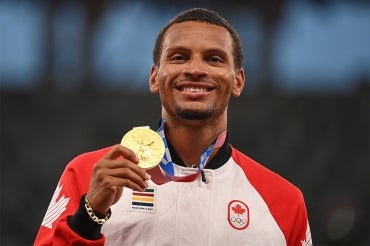Federal funding linked to more medals for Canadian Olympians – but less participation in grassroots sport: Study

Canadian federal funding in sport is associated with more medals for Olympians like Andre DeGrasse, gold medalist in the men's 200-metre sprint at the Tokyo 2020 Olympic Games, and reduced participation in sport among recreational athletes, according to U of T researchers (photo by Ina Fassbender/AFP/Getty Images)
Published: July 9, 2024
Federal funding for sport is associated with Canadian athletes winning more Olympic medals – but this comes at the cost of reduced participation in grassroots recreational and competitive sport.
That’s according to a report from the Centre for Sport Policy Studies at the University of Toronto’s Faculty of Kinesiology & Physical Education that delves into the relationship between high-performance sport and grassroot participation.
The research calls into question the notion that funding of high-performance sport – and resulting success of elite athletes on the world stage – has a “trickle-down” effect by inspiring people to participate in sport and physical activity.
“We do not dispute that excellent performances by national athletes are inspirational. However, the effect of inspiration on increasing participation is far less clear,” says Peter Donnelly, a professor emeritus of sport policy and politics at the Faculty of Kinesiology & Physical Education, who co-authored the report with Bruce Kidd, professor emeritus of sport and public policy and former Olympian.
The researchers argue that inspiration is not enough to break down the barriers that prevent many young people from participating in sport. “Family income, gender/sexuality, (dis)ability, geographical location and other factors can all, individually and in combination, have an enabling or a constraining effect on the possibilities of participating in organized sports,” says Kidd.
The researchers used data on sport participation, Sport Canada’s annual budgets and statistics on Olympics medals won by Canadian athletes since 1988 to examine the relationships between participation in sports, funding and Olympic successes.
“Prior to 1970, the federal government tried to invest in high-performance sport, broadly based participation and physical education in equal measure, and made multi-year shared-cost grants to the provinces and territories to assist with broad-based participation,” says Kidd. “In 1970, it established Sport Canada with a high-performance mandate and unilaterally withdrew from its support of provincial and territorial programs.”
This led to an ongoing decline in participation in organized, competitive sport among Canadians over 15 years of age – from 44 per cent in 1990 to around 27 per cent today.
While there are other factors that can help to explain this decline, including an aging population and rising costs of participation, the researchers point to shifting federal priorities and the structure of Canadian sport policy as the reasons for increased investments in international sport success and decreased investments in grassroots participation.
“Data in other countries show a similar pattern – more money means more medals, and medals cost a lot,” says Donnelly.
In the 16 years since the Beijing 2008 Olympics, the Sport Canada budget has more than doubled, now sitting at more than a quarter of a billion dollars each year, according to the report.
”As other countries in the ‘sporting arms race’ increase their budgets and expectations, it will cost more and more money just to stay in the same place in the Olympic medal table,” says Donnelly.
“This has the potential to distort a national sport system in two ways: First, most funding is directed to those sports where national sport leaders see the greatest chance of being able to win medals; and second, the vast majority of government funding for sport tends to go to high-performance sport.”
The researchers offer the following solutions in their report:
- Survey national, provincial and territorial sport organizations to determine their capacity to incorporate new participants.
- Develop an ‘open house’ strategy during and immediately following major Games for the public to try out different sports, with coaches, athletes and – where possible – former Olympians present to talk about their sports.
- Target children and youth; low-income individuals; Indigenous, ethnocultural and immigrant communities; and, for certain sports, persons with a disability and older individuals looking for a form of physical activity.
- Re-invigorate school physical education programs, intramural and extracurricular sports; engage coalitions of sport organizations in offering free basic skills development programs for those past school age.
- Ensure widespread publicity for the participation initiatives.
- Develop a clear subsequent use policy for major Games facilities that includes grassroots participation, similar to the Toronto Pan Am Sports Centre, jointly managed by the City of Toronto and U of T.
- Develop an evaluation strategy to determine the success of participation initiatives introduced in association with major Games.
The researchers say they are encouraged by the recent announcement by Carla Qualtrough, Canada’s minister of sport and physical activity, that she will review the Canadian sport system and recommend options for reform.
“People may be inspired by the achievements of high-performance athletes,” says Donnelly. “However, if the material and structural conditions of participation are the same after the Games as they were before, then all the claims of a legacy of increased participation become empty promises.”



